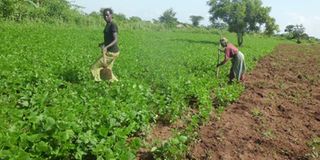East Africa countries to review cereals and pulses’ standards

With good practices from the farm to post-harvest, the produce will be able to meet the quality standards for regional trade. PHOTO BY LOMINDA AFEDRARU
Farmers and traders in East Africa dealing in cereals and pulses will have to observe common standards across the region when the process of harmonising them is finalised.
Each country have their own standards, which poses a challenge to trade across the region. But, in 2005, an effort to develop the same standards across the value chain for grains and pulses.
This was accomplished in 2013. In total, 22 standards were developed but various stakeholders raised concerns about some of the conditions being too stringent to enable trade and, therefore, there was need for a review.
Access markets
Out of these, the five in focus cover maize, millet and wheat grains as well as dry beans and soya beans.
Lilian Bazaale, the country manager, East African Grain Council (EAGC), during a meeting held in Kampala last week, explained that the standards for these crops vary from grade one, two, and three for crops such as maize, beans, soya beans and millet grain and for wheat grain the grades are four.
The main aim of the review is to enable those involved in trade of these to access regional markets with ease. This way, the farmer will be a beneficiary because if the standards are stringent, some farmers may not be able to sell their produce.
Each country is to come up with a position to be presented at a regional meeting, due to take place in Kenya, to conclude the harmonisation.
Specifics
EAGC, in partnership with Usaid Feed the Future and Uganda National Farmers Federation, among others, are training farmers on good farming practices and post-harvest handling that will enable them meet the standards.
As a case in point, Bazaale pointed out that Ugandan farmers and traders can benefit because Kenya and Rwanda, have a huge market for Ugandan grain.
Arthur Tabuka, a laboratory analyst, Uganda National Bureau of Standards (UNBS) while explaining the exercise, noted that complaints from farmers were that the standards where complex especially the language used, and that they could not meet certain specifications.
What is spelt out in the draft standard specifies the accepted quantity of foreign matter, inorganic matter, broken kernels, pest and disease damage, discolored grains, moisture content, immature and shriveled grains where the magnitude is computed into percentages for the different grades.
For instance, for the maize grain, the amount of foreign matter expected to be in grade one is 0.5 per cent, 1.0 per cent for grade two and 1.5 per cent for grade three.
There are limits for existence of heavy metals in the grain such as lead and cadmium, also mycotoxins such as aflatoxin which is limited at 5 per cent.
Others are microbiological limits such as moulds and yeasts plus specifications such as packaging materials, weights and measures and labeling among others.
Microbes such as Escherichia coli and salmonella, should be completely absent in these grains because they are harmful to human health.
Free from harm
The rest of the crops have up to three grades but the wheat grain is graded from grade one to four. Its specifications include moisture content (14 per cent for all grades), bulk density specifying packaged weight in kilogrammes, protein, un-millabale material, edible grain and other wheat varieties apart from the specific packaged variety.
All the standards specify that theyshould be free from organisms, which are harmful to human health. Thus, the aforementioned grains and pulse crops should be safe for human consumption.
The implementation is expected to be carried out in the local as well as export markets.




